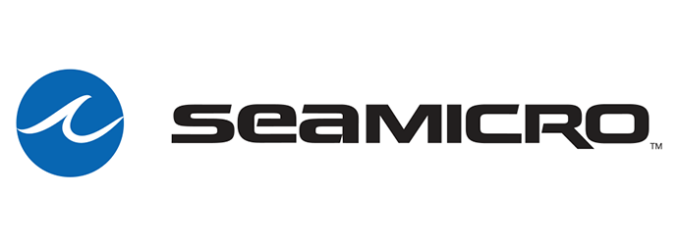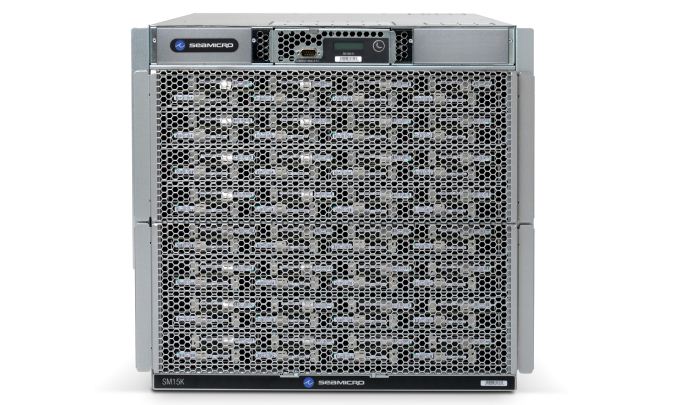AMD Exits Dense Microserver Business, Ends SeaMicro Brand
by Ryan Smith on April 16, 2015 5:30 PM EST- Posted in
- CPUs
- IT Computing
- AMD
- SeaMicro
- Microserver
- Servers

AMD’s Q1’15 earnings announcement just came out a bit ago, and while we’re still waiting for the analyst call to take place to get more details, there is one item we want to get to right away, and that’s the fate of AMD’s dense server business. As part of today’s earnings release, AMD has announced that they’re existing the dense server system business – operating under the SeaMicro brand – effective immediately.
AMD initially acquired SeaMicro back in 2012 for $334 million as part of their larger play into being an agile company, aiming to take a big chunk of what was expected to be a fast-growing market micro/dense server market. In the microserver model, servers are built using very large numbers of lower performance cores, making the servers leaner, more power efficient systems for tasks that involve large numbers of low-impact threads (think: web servers). This in turn mapped well to AMD’s processor designs, where both the Bulldozer and Cat families would be well suited for such a design, not to mention AMD’s future ARM based CPUs.
SeaMicro’s first product post-acquisition was the SM15000, a dense server design announced in late 2012 that offered either AMD “Piledriver” Opterons or Intel “Ivy Bridge” Xeon CPUs. However as it turns out that first design was also the last design; SeaMicro did not release any additional products prior to today’s announcement from AMD.
Jumping back to today, AMD’s announcement comes as the company is continuing to try to find a solid foothold as a semi-custom silicon company, to which it would appear that the SeaMicro business no longer fits into. AMD’s initial announcement does offer a bit of insight as to why they’re exiting the business – to “sharpen and simplify” what the company invests in – and we’ll likely hear more on today’s call.
Meanwhile it’s worth noting that we haven’t heard anything from SeaMicro in some time now, so today’s announcement is perhaps not all that surprising. Still, AMD’s first ARM processors were set to ship this year – the Opteron A1100 – which would have been a good fit for the SeaMicro servers. However A1100 itself appears to be behind schedule at this time, as AMD has yet to bring A1100 to market beyond last year’s development kit.
Anyhow, as part of exiting the dense server business, AMD will be taking a $75 million dollar special charge, which is “primarily related to impairment of previously acquired intangible assets” and will include a $7 million cash payment. Meanwhile AMD’s announcement doesn’t say what will become of the SeaMicro team – at this point we’re not entirely sure how large it is after AMD’s most recent restructuring – though I wouldn’t be surprised if they at least rolled some of that expertise into future ARM server CPUs. As for the SeaMicro brand itself, with AMD’s exit the brand has been shuttered, and AMD has deactivated the SeaMicro website.
Update: Here are the prepared remarks from AMD's CFO regarding SeaMicro
At the corporate level, we continue aligning larger portions of our R&D investments to take advantage of long-term growth opportunities across our EESC segment. As we prioritize our R&D investments and simplify our business, we made the decision in the first quarter to exit the dense server systems business as we increase investments in our server processor development. We retain the fabric technology as a part of our overall IP portfolio. We see very strong opportunities for next-generation, high-performance x86 and ARM processors for the enterprise, datacenter, and infrastructure markets and we will continue to invest strongly in these areas.












60 Comments
View All Comments
Taneli - Friday, April 17, 2015 - link
Especially Samsung with their competitive fabs and large end user sales would be interesting.nofumble62 - Thursday, April 16, 2015 - link
IP? each patent cost about $20K to file. Can AMD afford it?looncraz - Thursday, April 16, 2015 - link
From my understanding, AMD cannot be bought out, they will lose their x86 license.chizow - Friday, April 17, 2015 - link
Exactly, the only way it could happen is if Intel signed off and allowed the license to transfer, which they mmight consider to avoid anti-trust scrutiny. But it would have to be the right buyer, they wouldn't allow it to transfer to a high market cap company like Samsung or Qualcomm simply because that would challenge their x86 dominance. Something like Via would be a good, safe landing spot for that x86 license.anubis44 - Friday, April 17, 2015 - link
VIA already has Cyrix's old x86 license, which they obtained when they bought them out over a decade ago.Penti - Friday, April 17, 2015 - link
Actually they don't they lost all previous licenses and agreements when they bought Cyrix from National Semiconductor, and they lost the license Centaur had when they bought Centaur from IDT. It was all settled after court battles and because it was deemed Centaur owns patents and thus invented tech which Intel needs to use they settled and gained an x86-license that way.AMD is a public company so anybody could buy them but you might get into trouble when you get the controlling majority or if you wish to merge the company. The agreement is obviously not transferable to another business. VIA didn't really purchase businesses that did have x86-licenses just the design companies that worked for National and IDT.
fluxtatic - Friday, April 24, 2015 - link
Point is, Via holds an x86 license. At that, though, they've never shown any interest in competing with Intel or AMD. They do their industrial/embedded thing with it, and seem to be happy enough about it.What I wonder is how that might go if AMD goes under/decides to sell out. Intel holds rights of refusal on the transfer of AMD's x86 license, but what does that look like once government regulators start to look into it? That is, say Samsung steps in, Intel says (without really saying, of course) "no, sorry, you might actually provide competition, no x86 license for you." Would the government say, "too bad, they've got the money and you damn sure don't get to be the only license-holder in the markets you play in"?
anubis44 - Friday, April 17, 2015 - link
Not quite. If a 'change of ownership' happens, AMD will not automatically 'lose' their x86 license, rather, the current licensing arrangement comes up for renegotiation. Many assume that means Intel would refuse to continue the current licensing arrangement, but those people miss the fact that AMD licenses AMD64 instructions to Intel. Yes, that's right Intel users. Your Intel processors are running 64bit AMD microcode, deep down in their little cores. So, basically, if Intel refused to license x86 instructions to AMD, AMD could revoke Intel's license to run AMDx86-64 instructions. Basically, it would be thermonuclear war. So, the common consensus is that another company could buy AMD, and probably renegotiate essentially the same cross-licensing arrangement AMD already has with Intel. In other words, it's not that much of a big problem for a prospective buyer of AMD, especially one with deep pockets like Samsung, Qualcomm or Apple.andychow - Tuesday, April 28, 2015 - link
You're wrong. The AMD Intel truce is quite specific:6.3 Change of Control. In the event of a Change of Control of AMD, the definition of AMD Microprocessor as defined in Section 1.5 shall be limited to those devices that fell within Section 1.5 on the date of the Change of Control and shall further be limited to x86 AMD Microprocessors for use in a Personal Computer.
“Change of Control” shall mean:
(1) any Person or group of Persons (as the term “group” is interpreted pursuant to Rule 13d-5 under the Securities Exchange Act of 1934, as amended) (the “Acquiring Person”) acquires (i) beneficial ownership of capital stock of AMD entitling the holder(s) thereof to more than fifty percent (50%) of the voting power of the then outstanding capital stock of AMD with respect to the election of directors of AMD, or (ii) an interest sufficient to receive more than fifty percent (50%) of the profits or losses of AMD; or
(2) AMD enters into a merger, consolidation, reorganization or similar transaction (or series of related transactions) with any Person or group of Persons in which less than fifty percent (50%) of the voting power of the outstanding capital stock of AMD (if it is the surviving entity) or of the Acquiring Person (if it is the surviving entity) with respect to the election of directors following such transaction is held directly or indirectly by Persons who were shareholders of AMD immediately prior to such transaction (or series of transactions); or
(3) AMD sells to any Person(s) in one or more related transactions properties or assets representing all or substantially all of the properties and assets of AMD.
Novacius - Thursday, April 16, 2015 - link
Buying seamicro was stupid right from the beginning. They should've known that they couldn't sell Intel processors any longer and that their own processors just weren't good enough. And it also seems that they didn't even tried, because they only released one model. I didn't knew that. What the actual f*ck? I doubt that the IP they bought with it was worth that.